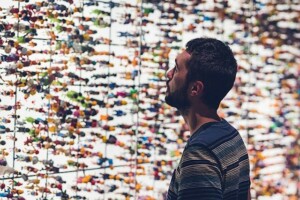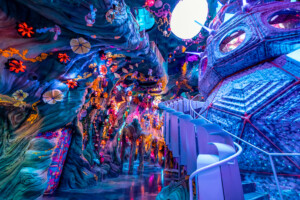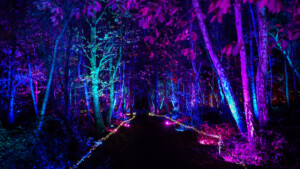Art & Technology, WET and Technifex were three of the companies started by former Disney Illusioneers following the Epcot layoffs in the 198 0s, and each had a strong hand in creating what we know as today’s special-effects industry for themed entertainment
0s, and each had a strong hand in creating what we know as today’s special-effects industry for themed entertainment
By Judith Rubin
Gracey, Novey and Disney
In the 1950s, Yale Gracey became the father of theme park special effects when he took on the job of designing effects for the first Disneyland dark rides.
In 1976, Bill Novey (right) created the special effects business when he built the special effects department of Walter Elias Disney (WED) Enterprises. Unofficially dubbed “Illusioneering” (to complement Imagineering), at its peak the department numbered between 100-200 people, brought on board to develop effects for Epcot Center and Tokyo Disneyland which opened in 1982 and 1983 respectively. After the completion of the latter two projects, Novey had the melancholy job of helping to dismantle his own department in the massive layoffs that sent hundreds of Disney-trained people out to try their luck in the world.
Novey would soon join the exodus with his own company, Art & Technology, incorporated in 1984 by Novey with friend and fellow Illusioneer Joe Garlington, along with Novey’s wife Jody Van Meter, and Garlington’s wife Shaunna. Initially operated out of Garlington’s garage, Art & Technology lasted until shortly after Novey’s death in 1991 at age 43.
Where are they now?
Many of the companies and caree rs that grew out of WED Illusioneering and its legacy are around and thriving today at the top of their industries.
rs that grew out of WED Illusioneering and its legacy are around and thriving today at the top of their industries.
Some key members of Illusioneering were Joe Garlington (now VP creative – interactive projects with WDI), Craig Newswanger (director of optical engineering at Zebra Imaging), Mark Fuller ( left -now CEO at WET), Bob Lambert (senior VP, worldwide technology, Walt Disney Company), Rick Hardenbrook (now of RLH Enterprises), Chris Runco (still with Disney), Jim Mulder (technical director at Garner Holt Productions – joined about two years ago to augment the company’s special effects division).
Monty Lunde and Rock Hall, principals of Technifex, were also part of Illusioneering. And today Jody Van Meter is VP marketing at Garner Holt Productions a company specializing in audio-animatronics.
The Haunted Mansion
“Yale Gracey (right) was a baling-wire-and-scotch-tape kind of designer who borrowed from traditional theatrical illusions to come up with sophisticated effects for Disney dark rides, ” said Greg MacLaurin (below left) of greg a go go. A special effects and conceptual designer who has been employed at WDI (7 yrs) as well as Universal (4 yrs), MacLaurin spent five years working for Art & Technology. Like many attractions industry professionals, he has  made a lifelong study of the industry and has eccentric hobbies, such as sculpting mummy’s hands and building ghost phones.
made a lifelong study of the industry and has eccentric hobbies, such as sculpting mummy’s hands and building ghost phones.
Another Disney veteran who helped usher in the era of special effects was Wathel Rogers. “Yale and Wathel were masters at taking things that weren’t complex technology – just immensely clever and well-executed – and turning them into credible effects, ” recalled Mark Fuller, who Bill Novey brought into Illusioneering and who later joined Novey at the head of the department. “Bill and I thought, ‘if this much can come from 19th century theatrical technology, just think what might be done with 20th century industrial technology!’” said Fuller.
“Yale Gracey’s forte was taking next to nothing to make an amazing illusion, ” agreed Monty Lunde, who started at Disney Illusioneering in 1981.
Disneyland’s Peter Pan ride took the audience on a flight with its hero out the window, over the streets of London and up into the stars to Neverland, to rescue Tiger Lily from a pirate galleon before crashing through a waterfall back to real life. Those who rode the original version of the attraction in 1955 saw what the Disney shop fabricated based on Gracey’s designs for the original effects. According to Greg MacLaurin, this is how those effects were done: The traffic of London, seen as from far above at night, was simulated with a chain drive painted with ultraviolet paint and illuminated by black light. Similarly, the star field was done with hundreds of plaster balls dipped in ultraviolet paint and mounted on rods. The rippling waterfall effect was achieved with a piece of rippled glass rotating in front of a high-intensity light source projected on exit doors painted gray in a rippling pattern.
By the 1960s, two things happened to make Disney special effects more robust. Gracey now had more engineers to retool his mockups into something more durable, and through Disney’s work on corporate pavilions for the 1964-65 New York World’s Fair the entertainment company gained experience in producing effects for larger attractions with higher throughput. Disney’s work at the world’s fair included Small World, the GE Carousel of Progress, the talking Abe Lincoln animatronic and Ford’s Magic Skyway.
In 1969, Disneyland opened Haunted Mansion, the attraction for which Gracey is best known and which still holds up well today. Haunted Mansion features applications of the illusion known as Pepper’s Ghost, in which guests see what appear to be three-dimensional objects but are actually reflections.
 A dream come true
A dream come true
“At age eight Bill Novey had been to Disneyland and already decided that he wanted to head Disney’s special effects department when he grew up, ” said Joe Garlington. Novey prepared himself by learning magic tricks as a youth and studying engineering and chemistry. He emerged from undergraduate studies with Bachelor’s degrees in mechanical engineering and electronic engineering, but his first attempts to get hired at Disney failed.
After spending time on a number of other projects including working on the first artificial kidney at the University of Chicago, putting together one of the first electronic studios for John Cage and devising a Ferris wheel braking system for Eli Bridge Co., the 28-year-old Novey enrolled at California Institute of the Arts for a Master’s in theater technology because he’d learned that Cal Arts had Disney connections. While earning his degree, Novey worked summer interships at Disney (“while he still had a ponytail, ” said Jody Van Meter). Upon graduation he realized his lifelong dream, becoming the fulltime head of WED Illusioneering.
“Bill brought a whole new level of education to the job – an intense focus and level of training, ” said Garlington. “He rapidly became known as a genius and it became critical to include Bill on design teams. He had a knack.” Before long, no Disney project team was complete without somebody from Novey’s crew of special effects wizards. And even after Novey became seriously ill with lymphoma, his dedication never waned. “He’d leave for treatment on Fridays and be sick all weekend, then come in Monday and work a long, hard week, ” said Garlington. “Bill invented 300 projectors and oversaw the creation of 6, 000 effects for Epcot and Tokyo Disneyland.” A specialist in interactive design, while at Disney Garlington pioneered the use of video in Pepper’s Ghost entertainment applications. (For more Epcot memories see: Theme Park and Epcot Reflections: a Conversation with Steve Alcorn and Peter Ed)
The corporate funding behind the Epcot pavilions fueled the Disney artists as never before, and the new park featured many effects innovations. In the Journey to Imagination pavilion alone were the following:
– First use of a hologram in a theme park

– The Epidiascope – a slide projector that transformed the projected image by means of a movable clear glass object in place of a slide
– First vector-scanning laser projection in a theme park setting
– First time of recording the audience on video and later playing back the recording to the audience as part of a theme park show
Also of note:
– First use of laminar flow technology in fountains (outside the Imagination pavilion)
– First use of video imagery in a Pepper’s Ghost application (the Astuter Computer Review theater)
Art & Technology
Disney’s hardworking Imagineers and Illusioneers kept to a fierce production schedule to turn out Epcot and Tokyo Disneyland, and the pre-opening slogan was “We Can Do It!” After the 1982 opening, it was “We Did It!” (which rapidly gave way to “We’re Fired!”)
The first important contract for Art & Technology was with the New Mexico Museum of Natural History, then under construction in Albuquerque. “Museum director Jonathan Callender hired us in spite of our nonexistent track record, ” recalled Garlington. The company created a walk-through volcano, a Cretaceous hall of sculpted dinosaurs in an environmental diorama and the Evolator – the first-ever motion simulator in a museum. All exhibits are still up and running at the museum.
Such exhibits in a museum were unprecedented at the time and many considered them violations of what educational exhibits should be. According to Garlington, Callender was more or less forced to take the approach he did because New Mexico had a shortage of artifacts – a museum in Denver had long ago acquired New Mexico’s dinosaur bones.
Other memorable Art & Technology projects included interactive exhibits for the Los Angeles zoo, a suit of armor that changes color at Busch Gardens Williamsburg, and a special holographic/fiberoptic effect the company invented for the E.T. ride at Universal Studios Florida.
Eventually Garlington sold out to Novey, who continued to run Art & Technology with Van Meter. But then Novey became seriously ill again and succumbed to the aftereffects of his cancer treatment. “Bill was the best guy I ever worked with, ” said Garlington. “He was so bright and so fun. He had passion, interest and focus.”
Van Meter remembers Novey as an eternal tinkerer. “Bill got caught up in the wine glasses at a store once, turning them in the light. He selected one particular glass, bought it and had the technicians at work run tests on it to gauge just why it reflected light the way it did.”
From WED to WET
If Joe Garlington was the “art” and Bill Novey the “technology” of Art & Technology, at Disney Illusioneering Novey was “the projection man” and Mark Fuller was “the water man.” And as did Novey, Fuller spent considerable time knocking before the Disney door opened to him. “I had a friend in the architectural division at Disney, ” remembered Fuller. “He snuck me in for a tour and I knew I had to work there.”

Fuller (left, today) sent in his resume at regular intervals for six years and finally, while a graduate student in product design at Stanford, “I met an engineer who knew John Zovich at Disney and he helped me get an interview. I showed my portfolio on slides, which included pictures of fountains and special effects I’d been building since I was a kid, ” said Fuller. “Zovich called in Wathel Rogers and had me show the slides over again, and Wathel called in some others, and they called in some others. It lasted six hours but the next morning I got a job offer.” Fuller soon became co-supervisor of Illusioneering with Bill Novey.
Fuller had already done work as a student with laminar flow technology – work that would eventually lead to the creation of four famous fountains still running at Epcot: the leapfrog, the jellyfish, the popjet and the upside-down waterfall. Laminar flow makes water molecules proceed in an orderly fashion that makes the water appear solid and very clear, like glass and combines well with fiberoptic lighting.
Fuller and staff engineered a way to make the water jump and turn on and off – as it does today in the leapfrog fountain – but they needed solid support from Disney to develop the technology into fountains. Higher-ups in the company were not particularly impressed with laminar flow. 
Fuller got his chance from show producer Barry Braverman, who needed ideas for a kids’ area outside the Imagination pavilion and agreed to the concept of a fountain park. “It was my big chance, ” says Fuller. Marty Sklar (who recently retired as the creative leader of WDI) set up a time for Fuller’s group to demo the fountain idea to the Epcot steering committee. But Fuller had two problems: “We wanted to make a fountain in which the laminar streams would arc high enough and far enough for people to pass underneath them, but they weren’t quite high enough yet. Also, the laminar streams splashed badly and we hadn’t found a way to control that yet.”
Fuller’s team recruited a very small young woman working in the document control department and videotaped her interacting with laminar streams. Her Lilliputian scale gave the appearance that the water reached higher than it did. To conceal the splashing, they used a lot of illumination and a white sheet in the background. It worked. “Norm Doerges [now an independent consultant] said, ‘let’s do it.’”
Some opposition to Fuller’s ideas remained. “An operations person took me aside, ” recalls Fuller. “He said, ‘I think it is a disgrace that this company lets a young kid out of school waste so much money on a stupid idea.’ After the leapfrog fountain opened and was an instant success, he called to apologize.”
Wanting to work exclusively with fountains, Fuller left Disney and founded WET in the early 1980s. Today, WET fountains are found in architectural and entertainment settings all around the world, complementing the work of such leading archite cts as I.M. Pei, Kevin Roche and Philip Johnson. A recent high-profile project is the Dubai Fountain. In March 2010, Fuller will be presented with the Themed Entertainment Association Lifetime Achievement Award.
cts as I.M. Pei, Kevin Roche and Philip Johnson. A recent high-profile project is the Dubai Fountain. In March 2010, Fuller will be presented with the Themed Entertainment Association Lifetime Achievement Award.
Technifex and the Baltimore Power Plant
After spending a couple of years building full-scale mockups of art directors’ ideas at Disney Illusioneering (“I was a lowly scrub who did what I was told – with a creative flair, of course”) Monty Lunde (above right) was transferred to Florida to oversee special effects for the Epcot Horizons pavilion, where he was involved in building many prototype projection and mechanical effects and also contributed to the Imagination pavilion, the Mexico pavilion and the American Adventure pavilion.
After leaving Disney in the early 1980s, Monty Lunde and Rock Hall (a fellow effects designer at Disney) got their big break in a deal with Gary Goddard Productions and Six Flags. Goddard’s company was designer for Six Flag’s new project, the Baltimore Power Plant – an early incarnation of what an urban entertainment center. The short-lived Power Plant (it remained open two years) was an indoor walk-through multimedia experience retrofit of an actual power plant on Baltimore’s harbor. Lunde and Hall arranged to spend a year on the project during which they would set up shop for themselves, providing their work to Six Flags at cost but retaining the capital equipment. “We worked 16-18 hour days, seven days a week, but we ended up with a company, ” recounts Lunde, who in 1991 founded the Themed Entertainment Association.
The Baltimore facility was themed around a fictitious fellow named Phineas T. Flagg, a Jules Vernian type who had discovered all sorts of oddities and put them on display at the Power Plant. The talking leprechaun is probably the best remembered of the cornucopia of effects created for this project.
Technifex grew into a versatile and successful company working in mechanical effects, water and fire features, atmospheric effects, projection and lighting effects, show control systems, film and video production and 3D/4D theaters. A recent project was the Audubon Insectarium in New Orleans.
( Related: We Can Just Leave Right Now … Theming, Presidential Libraries and Space Shuttles / Audiovisual technology: A short history of the videowall / Transitioning from Corporate to Independent in the Themed Entertainment Business / A UK family with three children visits Orlando )

Bill Novey’s Special Effects Menu
I. Projected Special Effects
A. Advantages
1. get projected animated imagery without the complexity or investment of motion picture equipment and film
2. only two or three moving parts
3. low cost compared to film
4. artwork has a long life
5. low maintenance compared to film
6. equipment takes up less space than motion picture projector
7. no operator required
8. no projection booth needed
B. Typical Projected Effects
1. steam, smoke clouds, drifting fog, swirling effects
2. erupting volcano, flowing lava
3. lightning flashes and strikes, sparks
4. water ripple, reflection, waterfall, flows
5. rotating and tumbling images
6. flying, falling, rising, moving images
7. moving images with animated sections
8. kaleidoscopic projections
9. liquid projections, bubbles, waves
10. aurora borealis, lumia, abstract light effects
11. twinkling stars (when fiber optics cannot be used, such as on rear-projection screen)
12. spinning galaxies in perspective, comets, rotating space stations, pulsars, meteor showers, shooting stars and any astronomical phenomena
13. fire, torches, forest fire
14. expanding rings
15. ghosts, distorted images
16. explosions, flashes
II. Laser Effects
A. Typical Effects
1. image scanning on a screen, scrim or shape
2. beamwork through fog or smoke atmosphere
3. laser illuminated fiber optics, acrylic sculpture
4. laser targeting where a beam locks onto a moving object eg. the beams that appear to exit the Dragon’s eyes in the Universal Studios Conan show.
B. Simulated Laser Effects
1. beams, cones, planes that touch the guests
2. scanned graphics on a screen
III. Holographic Effects

A. Techniques
1. static images
2. moving images
3. color images
4. holographic projection screens, appears to be a clear piece of film, but will show up an image projected onto it
B. Image Positions
1. behind film
2. in film plane
3. in front of film
IV. Real Imaging (floating 2D or 3D images in space)
A. Types
1. single concave mirror (witch’s apple in the Snow White dark ride)
2. double concave mirror
3. lenses (the floating face at the now defunct Magic Pizza)
4. optical illusions
5. other optical systems
V. Mirror Gags
A. Types
1. beam splitter imaging (Pepper’s Ghost effects)
2. infinity effects (hall of mirrors) or other images
3. first surface magic illusions (typically used to conceal space or hide a mechanism)
4. partially silvered glass effects (hitchhiking ghosts, images that you can see through a mirror)
VI. Miscellaneous Lighting Effects
A. Types
1. glowing “hot” rocks, metal, etc.
2. flicker light electronic circuit, for candles, embers, lanterns
3. polarized lighting effects – “Polage” art, Polarmotion animation crysta
4. edge illuminated plex, layers of etched plex animation
5. blacklight, changing, strobed, revealed, projected
6. strobed light, color changing strobes, single flash, strobed projected images
7. chasing lights systems
VII. Gas Discharge Effects
A. Typical Effects
1. standard neon
2. micro-neon (miniature tube diameters, as used in the models on the film One From the Heart)
3. crackle neon (large diameter neon tubes or shapes filled with pieces of glass, so the neon follows a jagged path around like miniature lightning)
4. spark jars, tubes, spheres (the types that will attract a safe spark to your hand) using Tesla coil-driven plasmas
5. portable neon (runs on battery operated high voltage power supplies that are miniaturized)
6. Tesla coil sparks (giant loud lightning type discharges in free air)
7. chasing neon (wipes up and down the tube)
VIII. Fiber Optics
A. Typical Technologies
1. end lit points
2. end lit points viewed through a diffuser
3. edge lit fiber by tungsten-halogen lamps
4. edge lit fiber by HID lights
5. edge lit fibers by laser
6. sculpted arrays of fiber
7. fibers illuminating edge lit etched plex
8. fibers illuminating plex shapes
9. giant fibers illuminating fluids
10. giant fibers acting as remotely programmed lighting sources
B. Typical Effects
1. stars, static or twinkling, shooting stars
2. magic pixie dust in objects
3. sparkles in air
4. simulated laser beams
5. animated arrays of patterns, kaleidoscopic, etc.
6. fountain lighting
7. water lighting for various colors
8. underwater programmed lighting effects, whirlpool
9. animated signs
10. volcano sparks
11. fireworks, rockets
12. twinkling gems, eyes, city lights
13. lights in trees
14. sculpture lighting
15. beams from ray guns
16. electricity
17. edge illumination of etched acrylic panels
***********Postscript from Monty Lunde
“Having read through the article and Bill Novey’s old list of effects, I can't believe it's been almost 20 years since Bill passed away. He was the one who interviewed and hired me right out of college. I can tell you that many of the systems he talks about are still employed [at Disney parks]. Where there have been major changes (due to technological advances) are with projection systems. Where we used to develop and invent very unusual still projection systems (I did this a lot during my time at Disney) we can now use video projection systems, or other video based display technologies to do the same thing, usually better. The reflection systems, lasers, holographic effects and the various other effects Bill talks about are still in our repertoire here at Technifex and I would think at Disney. Many of these are what we call finesse effects in that they are not simple engineering exercises and require a bit of artistry to get right. As a result, there aren't many companies that still do them.” – M.L.
**********Postscript from Greg MacLaurin
“As I think of special effects, I remember Bill Novey. He was for me, as he was for many others, my entrance into special effects as a career. And I remember, at Art and Technology, late at night, as he and I would churn out new proposals and bids, we would talk. We would talk of the huge scope of special effects. To remember priests in ancient Egypt, creating wonder devices in temples so that stone statues talk and tiny water wells never go empty. To zoom to the other extreme and see today's CG games, filled with dreams and stories, remembering that the computer itself is a device, created to extend our thoughts out of our own head and share these thoughts with others. And to remember that our goal with special effects is to take the thoughts out of our heads, and wrap baling-wire and scotch-tape, concrete and rebar around these thoughts, and share them with others. It's good to keep this focus.” – G.M.
Images from top:
The new Great Moments with Mr Lincoln, courtesy Disney.
Bill Novey
Young Mark Fuller, early days at Disney, courtesy WET.
Yale Gracey poses in the original Haunted Mansion attraction, courtesy Disney.
Greg MacLaurin is engaged on the Judy Garland ghost phone.
Jody Van Meter at the offices of Garner Holt Productions.
Mark Fuller today, courtesy WET.
Young Monty Lunde and projector at Disney Illusioneering, courtesy Technifex.
Baltimore Power Plant, courtesy Technifex.
Postcard of the original Peter Pan ride.
Another Lincoln image, courtesy Disney.










